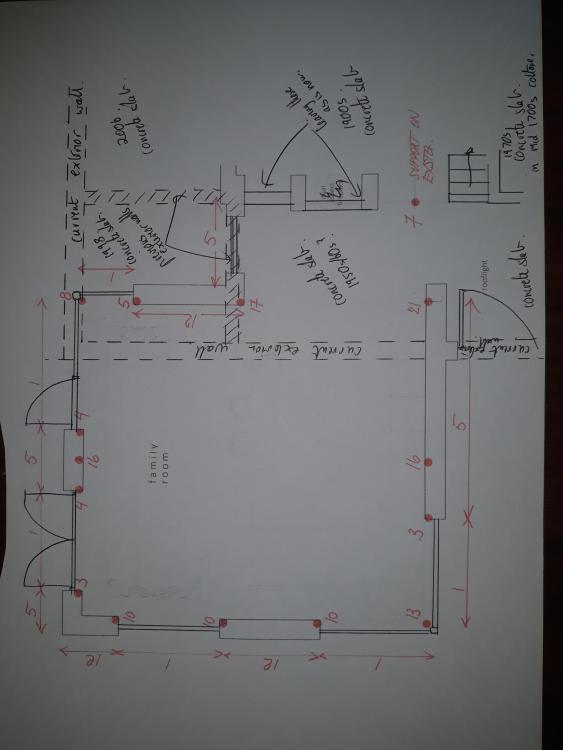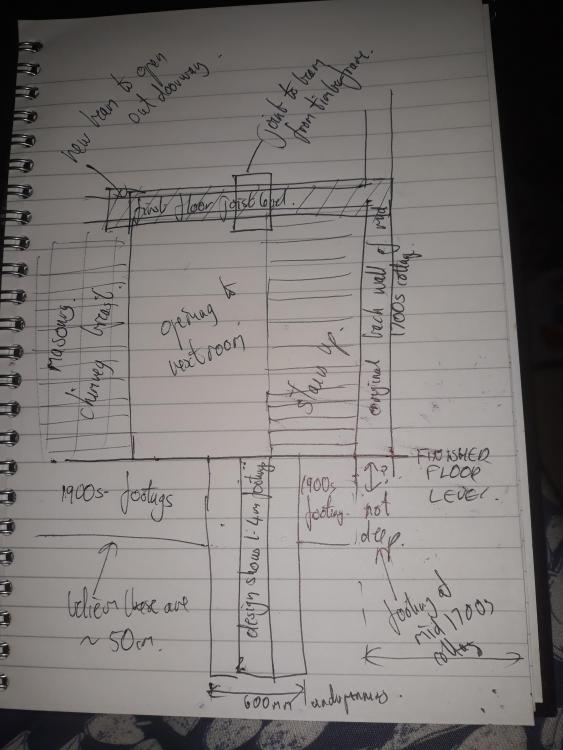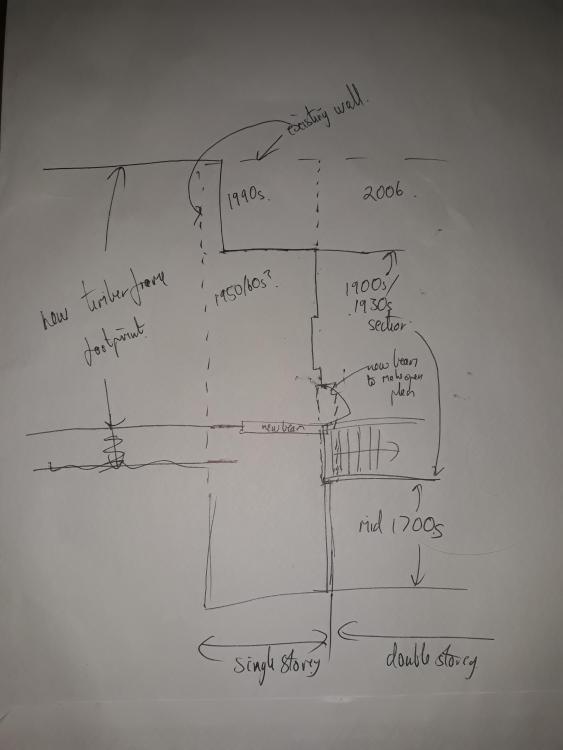
SugarPlum
Members-
Posts
9 -
Joined
-
Last visited
Recent Profile Visitors
The recent visitors block is disabled and is not being shown to other users.
SugarPlum's Achievements

New Member (2/5)
0
Reputation
-
Can someone explain to me what I am missing?
SugarPlum replied to SugarPlum's topic in House Extensions & Conservatories
Thanks Gus. I think decoupling seems to be the right approach here, just need to find a Structural Engineer in my neck of the woods that agrees now! The concept of underpinning just doesn't sit right with me at all, partially because it means we can't afford to complete the extension, but mostly because I am trying to preserve the old parts of the house as much as possible. Whilst it's not listed, we're doing as much 'like for like' as we can in the old bits, and adding back in the original features that have been mishandled in the past and I'd personally be devastated if something we did caused damage.... This I totally get... I'm a Systems Engineer by trade, which means I spend my days designing technology and then making sure that the different engineering teams build their bits so they all work together. Decisions made in one area impact the other areas and need creative solutions to enable each team to deliver, whilst the whole still achieves its goal - lateral thinking is my bread and butter...and probably why I am not satisfied with the apparent 'design by numbers' approach that the original Engineers seemed to have... they were not that impressed that I kept asking questions...- 13 replies
-
- timber frame
- foundations
-
(and 1 more)
Tagged with:
-
Can someone explain to me what I am missing?
SugarPlum replied to SugarPlum's topic in House Extensions & Conservatories
This is the loads from the timber frame, which I have (roughly!) annotated with existing walls/foundations- does that help? The timber frame company have said that the frame will not load the existing house in any other way, which leads me to believe that the floor joists and roof joists run parallel to the 1900s wall with chimney breast. I've already had a conversation with the frame manufacturer about the possibility of shifting the loading points if it makes the foundation/floor design easier, but they were reluctant. I think we could live with not opening up over the stairs if it mean the structure of the extension was able to be independent.- 13 replies
-
- timber frame
- foundations
-
(and 1 more)
Tagged with:
-
Can someone explain to me what I am missing?
SugarPlum replied to SugarPlum's topic in House Extensions & Conservatories
Thanks Gus and Jilly. I have been thinking that decoupling the structures seemed like a logical thing to do (and indeed seems to be implied if you look sideways at the NHBC guidance on building a new property adjoining an old one as a proxy for extension guidance - the original Structural Engineers openly admitted they followed the NHBC guidance for new buildings, and when I queried that they - incorrectly, I believe - stated it would not be compliant from a BR perspective to do anything else). I have today got in contact with some Structural Engineers who specialise in conservation work, hoping that they might take into account the effects on the entire building. Gus, you have me (more) worried about a ridge beam that the original structural engineers designed now - we converted the very low ceilings in the original cottage to vaulted ceilings. This necessitated a roughly 8m long steel beam, which rests on both ends on the masonry that is the interior face of a chimney breast.... I was already concerned that they had assumed these walls are cavity walls when in fact they are at least 250 year old single skin walls, now that's another thing to add to my worry list.... Gus, I will see what actual plans I can upload - slightly wary due to copyright and also the fact that we're likely to take legal action against the original structural engineers (for breach of contract law) so don't wan't to be plastering anything identifiable over the internet...- 13 replies
-
- timber frame
- foundations
-
(and 1 more)
Tagged with:
-
Hello, I posted this on the extensions group, but thought I would pop something in here in case there is a wider readership.... any insights appreciated!
-
Can someone explain to me what I am missing?
SugarPlum replied to SugarPlum's topic in House Extensions & Conservatories
Another sketch from an elevation perspective. The more I draw, the more it makes no sense.... surely this shows that all the new weight will bear on the original foundations? And the underpinning is doing nothing (other than introducing differential movement)?- 13 replies
-
- timber frame
- foundations
-
(and 1 more)
Tagged with:
-
Can someone explain to me what I am missing?
SugarPlum replied to SugarPlum's topic in House Extensions & Conservatories
A very quick sketch... hopefully makes some sense... I have tried to show two beams in a T shape, one is designed by the timber frame company as the mechanism to join to the existing house. The other is to remove a doorway and open up the stairs to be open plan to the room. The suggested underpinning would be directly under the beam designed by the timber frame folks, as would new footings. The dotted line by 1950s/60s and 1998 etc is the current external wall ( the house has a very complicated extension history...)- 13 replies
-
- timber frame
- foundations
-
(and 1 more)
Tagged with:
-
Can someone explain to me what I am missing?
SugarPlum replied to SugarPlum's topic in House Extensions & Conservatories
I don't think so. In terms of the join from extension to 2 storey part of the house, we are opening up a doorway to make the existing room more open plan which happens to be where the timber frame will join. It is a 7kN point load apparently, at first floor joist level. The load point would be above where the foundations would be underpinned, but given that this load point will be in the middle of another beam approx 1.5m wide, surely any load distributed to the foundations would not benefit from the underpinning? In terms of the existing footings, very little of the extension will rest on these, 95% of the frame is outside the footprint of the existing house. Hard to describe really, I could upload a sketch or two if it helps?- 13 replies
-
- timber frame
- foundations
-
(and 1 more)
Tagged with:
-
Can someone explain to me what I am missing?
SugarPlum replied to SugarPlum's topic in House Extensions & Conservatories
I don't understand why the foundation design calls for the removal of the existing ground floor and footings, which then necessitates underpinning of the older wall rather than reusing the more modern slab and footings. The only explanation I have had so far is that it is something to do with insurance which makes no sense to me...- 13 replies
-
- timber frame
- foundations
-
(and 1 more)
Tagged with:
-
Hello, First time posting, so be gentle, and sorry it's a bit long! We have an extension project in planning/just started building stage. For various reasons which I won't go into, I have sacked the structural engineers that were working on our project and am now left with an almost complete foundation design along with some part calculated beams where the extension will join the existing house. I tried, without much luck, to get the original and a possible replacement structural engineer to explain why the foundation design is as it is, and thought I would ask on here to see if anyone can explain to me why I appear to be being dense... (I am a Chartered Engineer by the way so I reckon I have a fairly decent brain, just not a structural engineer). The situation: we have a house that has been extended at various points in the past. The original is mid to late 1700s, followed by a 2 storey extension built we think sometime between 1900 and 1930 (single skin construction, slate dpc and no dpc under the quarry tiles bedded on thin concrete). Tacked onto the side of this part is a single storey extension that I am guessing is 1950s or 1960s - it appears to have cavity walling and a concrete floor, along with modern footings. Summarising slightly, but we are joining a 2 storey prefabricated timber frame extension to the side and above this single storey extension - the ground floor of which will be open plan - hence the current exterior wall will be demolished. The initial engineers designed a block and beam ground floor (clay soil, with trees around 15m away). We had soil analysis done and this recommended depths of 1.95 metres in one corner away from the current house, and 1.4m adjacent to the 2 storey part of the current house (i.e. a spot that is currently inside the house). The foundation design calls for the total removal of the concrete slab and the footings that make up the existing single storey part of the house. As the new footings would then join onto footings that will no way be to modern standards, let alone meeting the 1.4m depth specified by the soil analysis, they have said the existing house will require underpinning, but only where the new footings join the old. I don't understand why we can't keep the current footings and flooring and join onto them. Differential movement has been muttered by both the sacked and the potential new structural engineer, but again I don't understand how the design mitigates this - in fact to my mind it would exacerbate it...? In that if we carried out the design, one wall of our current house would be tied to the new, much deeper footings and at the join points would be rock solid, but surely that same wall would now be at risk of cracking because the footings are not even? And the other walls of the house that range from early 1900s footings (i.e. some, but not deep) to mid 1700s footings (I.e. almost none) could now move at a vastly different rate to the extension and that one wall of the existing house. Surely this will just introduce problems away from the extension? The prospective engineer suggested it is an indemnity issue - is that really it? Does that mean crack in new extension = insurance payout but crack in existing part of house that isn't the new extension = no pay out? Who's risk is actually being protected here??? Or am I missing something?? I look forward to any replies, hopefully someone will help me from tearing my hair out!
- 13 replies
-
- timber frame
- foundations
-
(and 1 more)
Tagged with:



